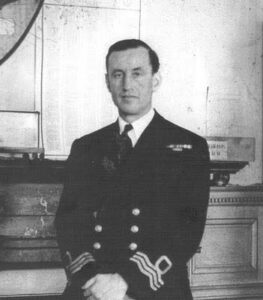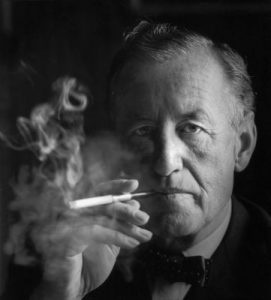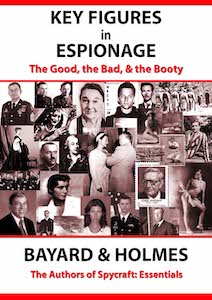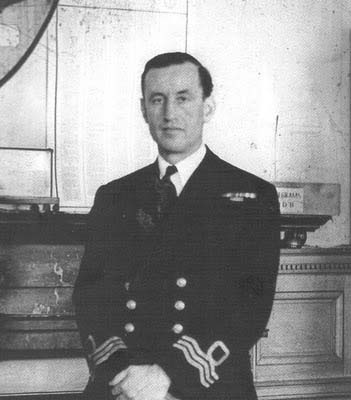Bayard & Holmes
~ Piper Bayard & Jay Holmes
Back in 2010, we decided that Halloween, with its ghostly trappings, was a great day to honor spooks of the Intelligence Community variety. Thus was born Love-A-Spook Day, which we have used to honor such greats as Virginia Hall, Josephine Baker, Billy Waugh, Eric Roberts, Jozef Gabčík, and Jan Kubiš. On this, our 11th Love-A-Spook Day, we look to the United Kingdom and Ian Lancaster Fleming, a man who wrote a myth, but whose real life was even more impressive than that of his fictional hero, James Bond.

Commander Ian Fleming
Photo Fair Use Exception
It is arguable that no Hollywood character has been more enduring or more popular over the decades than Bond—James Bond—novelist Ian Fleming’s never shaken, never stirred superstar agent of the UK’s MI-6. Watching the Bond movies would likely leave viewers thinking that Fleming possessed a good imagination and little or no knowledge of the grueling, tedious, and dangerous work done by real life intelligence operatives. Bond’s lavish spending on equipment and accommodations and the hours he wiles away tossing money around in posh casinos surrounded by lonely, glamorous women would make average MI-6 employees chuckle to themselves.
But while Fleming chose to write far-fetched plots that didn’t always bother to tie together details in a realistic way, he never let on that he was, himself, a spymaster who led two of the most successful teams of WWII.
Ian Lancaster Fleming, the second of four sons, was born to a wealthy Scottish-English family on May 28, 1908. Some sources say the family traces back to an Elizabethan intelligence operative, John Bond, whose motto was Non Sufficit Orbis, or, “The world is not enough.”
In 1910, Fleming’s father became a Member of Parliament. He then served as an officer in the Queen’s Own Oxfordshire Hussars during WWI and was killed in combat on the Western Front in 1917. Ian was nine years old. Winston Churchill wrote the obituary for Ian’s father, and it was published in The Times. “He was most earnest and sincere in his desire to make things better for the great body of the people.” Ian kept a copy of this obituary on his bedroom wall throughout his life.
Young Ian was sent to Eton. Sources contain contradicting information about this time in his life. Some say he was the greatest Etonian of all time, and others say he was a mediocre student who excelled at athletics. We ascribe to the latter school of thought. Either way, he served as co-editor of the college magazine, The Wyvern, which published his first short story, The Ordeal of Caryl St. George.
Fleming left his studies at Eton a term early to prepare to enter Sandhurst Military Academy. However, he didn’t complete the course at Sandhurst. Pro-Fleming sources aren’t going to be happy with us for saying this, but after less than a year at Sandhurst, Fleming contracted gonorrhea. This seems to be evidence that Ian may not have been in his room studying all the time. Staff were apparently pretty sure he was not in the library, rowing on the river, or on the obstacle course when he contracted it, either. In fact, contracting a venereal disease was a somewhat unique achievement for a Sandhurst cadet. Fleming moved on.
It entered Fleming’s mind, or at least his mother’s mind, that he should work in the British Foreign Office, so he traveled to Kitzbühel in Austria to perfect his abilities in German and French. He enjoyed his time there and later described it in a letter to a friend as “that golden time when the sun always shone.” After a year, he went on to study German and French at the Munich University in Germany and the Geneva University in Switzerland.
The brilliant Fleming mysteriously failed the Foreign Office exam in 1931 and did not opt to retest.
Instead, he took a position as a journalist with the Reuters news service and spent part of 1933 in Moscow. In retrospect, Fleming’s failure on the Foreign Office exam may have been arranged by MI-6 recruiters. It kept him “clean” of association with the British Foreign Office, perhaps enabling deep cover peacetime work for the British intelligence community.
Though Fleming reportedly enjoyed his two years as a journalist with Reuters, he found, like almost all writers, that writing rarely provides the lifestyle into which he had been born. Fleming moved on to become a banker and a stockbroker. It was during this time in 1934 that he met Lady Ann O’Neill, wife of Irish peer Shane O’Neill, who would become his paramour in 1939, and eventually his wife.
Also in 1939, shortly before the beginning of WWII, Fleming accepted a reserve commission as a subaltern in Britain’s renowned Black Watch regiment and became assistant to Rear Admiral John Godfrey, the Director of Naval Intelligence of the Royal Navy. During this period with Adm. Godfrey, Fleming helped formulate a plan of countermeasures to defend Gibraltar in case Spain should decide to align with the Nazis and attack it. This plan was known as Operation Goldeneye.
In contrast to the snail’s pace promotion world of the British Navy, Fleming quickly rose to the rank of commander.
His imagination served him well in naval intelligence, and in 1942, he commanded an elite special intelligence force known as 30 Assault Unit, or “30AU,” which was specially trained in intelligence gathering techniques. Fleming selected men for this unit that he felt had the intelligence and sophistication to recognize valuable information that normal commandos might not notice, and they operated in Europe with great success.
Fleming also helped found the highly successful “T Force” for the purpose of recovering Nazi technology from the collapsing Nazi empire at the end of the war.
Their task was to get to German technology before the Soviets or the Americans could get to it. The Nazis had developed several new weapons in the fields of rocket science, chemistry, jet engine and submarine engineering, and electronics that the Germans no longer had the industrial infrastructure to produce, or that they could not produce in significant numbers. T Force used a variety of sources to locate and acquire these technologies. More than once, Fleming’s mission inadvertently found him behind enemy lines, and he had to work his way out and back to safety. In the end, T Force was more successful than anyone imagined was possible. Anyone but Fleming, that is.
Fleming was also part of Operation Mincemeat, which helped convince Hitler that the Allied Invasion would take place in Greece and Sardinia in 1943 rather than in Sicily. The British planted false information on the corpse of a British serviceman and arranged for it to wash up onto the coast of Spain. The Germans picked up the body with the official documents and were fooled.
Fleming never spoke of his war-time activities to outsiders. Some say Allied commanders misused the 30AU before and during the main Normandy invasion, resulting in heavy casualties, and that this deeply impacted Fleming. To strangers and journalists, Fleming always minimized his war experiences with vague stories of a paper-pushing office life.

James Bond Beach, Orcabessa, Jamaica
Photo by Banjoman1, Public Domain
Near the end of WWII, Fleming attended an Anglo-American intelligence conference in Kingston, Jamaica. It was then that he decided that after the war was over, he would move to Jamaica and write “the spy story to end all spy stories.”
In 1947, he followed through and bought an old donkey racetrack on Oracabessa Bay. He named it “Goldeneye.” There are several theories about the origins of that name, but we favor the idea that Fleming took it from his first field task, Operation Goldeneye.
After WWII, Fleming took a job as the foreign manager of London newspaper Sunday Times.
Ann O’Neill had been widowed before the end of the war, but for their own reasons, she and Fleming did not marry at that time. Instead, she married Lord Rothermere and continued her love affair with Fleming. Then, in 1951, she became pregnant with Fleming’s child. Lord Rothermere divorced her. When Fleming sat down and wrote his first James Bond novel, Casino Royale, in January 1952, he joked that it was to distract himself from his impending nuptials. He married Ann in March, 1952, and their only child, Caspar, was born on August 11.
Fleming spent the first three months of each of the next twelve years until 1964 writing Bond novels at Goldeneye.
Casino Royale was published in 1953 by Jonathan Cape in the United Kingdom, to be followed by Live and Let Die, Moonraker, Diamonds Are Forever, From Russia with Love, Dr. No, Goldfinger, For Your Eyes Only, Thunderball, The Spy Who Loved Me, On Her Majesty’s Secret Service, You Only Live Twice, The Man with the Golden Gun, and Octopussy and the Living Daylights. Though Fleming is most famous for his Bond series, he also wrote The Diamond Smugglers, Thrilling Cities, and Chitty Chitty Bang Bang.
The first attempt to bring Bond to the screen was in 1954, when CBS produced an adaptation of Casino Royale for television under the name Climax! The show starred Barry Nelson as “Jimmy Bond.” It didn’t work out.
Then, in 1961, Albert R. Broccoli and Harry Saltzman teamed up to bring Dr. No to the big screen, which was the beginning of the longest-running, most successful movie franchise in history.
The dozens of Bond films over the decades are not only bold and exciting, they are a reflection of the last sixty years of changing social issues and attitudes toward war, space travel, feminism, realism in film, and exactly what constitutes a hero. The Bond character continues to evolve in step with changing social values and the politics of Big Media.

Ian Fleming
Photo Fair Use Exception
One charming story of Fleming is that he heard about a party to celebrate the production of a Bond movie that was made without his input. The party was held in the pool area of a hilltop mansion overlooking the Atlantic in the Bahamas, and it was crawling with British royals and other VIPs. The security effort was intense and included troops of guards with machine guns and guard dogs. Fleming allegedly slipped in through the security cordons, strolled through the crowd, and accepted a glass of champagne from a waiter. A few of the movie people who knew him recognized him, and, as a murmur grew in the crowd, Fleming stepped out of the light and vanished.
On August 12, 1964—his son’s twelfth birthday—Ian Lancaster Fleming died of a heart attack in Kent, England, at the age of fifty-six. He is interred next to his wife, Ann Fleming (1913-81), and Caspar Robert Fleming (1952-75), in the village of Sevenhampton, England, near the Welsh border.
We wonder if, when Fleming set out to write “the spy story that would end all spy stories,” he ever knew that he had done exactly that. He set the standard by which all that follow are measured. We have no doubt, though, that his real life exploits in espionage far exceeded those of his mythical creation.
This year, we honor Ian Fleming on our 11th Annual Love-A-Spook Day, not because he was the Man Who Wrote the Myth, but for his real life contributions to the fight against Hitler’s Third Reich.

* * * * * * * * * * * * * * *
Sir Sean Connery, the first man to portray the iconic James Bond in a movie, passed away today at the age of 90.
*BBC Obituary: Sir Sean Connery*
* * * * * * * * * * * * * * *
11th ANNUAL LOVE-A-SPOOK DAY SALE

With the voice of forty-five years of experience in the Intelligence Community, Bayard & Holmes explore the lives of the espionage elite.
- A one-legged woman operating behind Nazi lines, deemed to be “the most dangerous spy in all of France.”
- A young man left for dead, not worth a Viet Cong bullet, who survives to fight terrorists for six more decades.
- A homeless child who becomes an iconic showgirl, entertaining world leaders while running spy rings from the top stages of Europe.
A traitor operating at the top of Western intelligence who sells out his own, killing a thousand in his wake.
More heroic and more treacherous than any fiction Hollywood could produce are these genuine operatives of the Shadow World, who prove that “we’re only human” is not an excuse to fail, but a reason to succeed.
*BUY NOW*
“Key Figures in Espionage is a rollicking ride through some of history’s most notorious espionage personalities with a particularly interesting deep dive into the Cambridge Five. Well-researched and written, this book is great for not only the casual reader or spy fan but also for those who are more well-versed in the subjects.
~ Doug Patteson, Former CIA Operations Officer
“When it comes to research into the clandestine depths of spycraft, the dynamic duo of Bayard & Holmes have put together a must-read series that is written with authority, yet easily digestible. I’ve already added their books to my shelf of writing essentials—you should, too!”
~ James Rollins, #1 New York Times bestseller of Crucible

Recent Comments